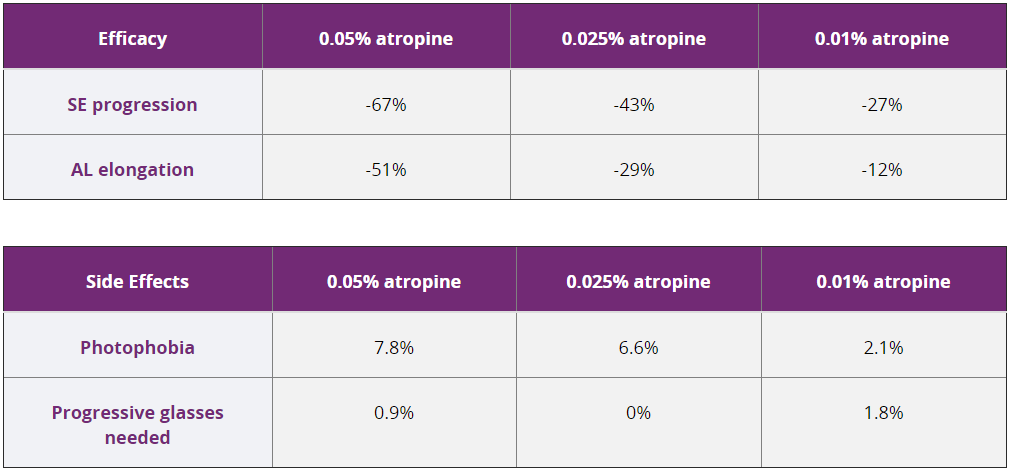Myopia, or shortsightedness, is the most common ocular disorder worldwide. Several international studies suggested atropine eye drops could slow down myopic progression in children, and thus lowering the risk of sight-threatening eye diseases associated with high myopia. However, the main concerns that deter the use of traditional atropine drops include the loss of focusing for near reading, and photophobia (excessive sensitivity to light) due to pupil dilation.
The Faculty of Medicine of The Chinese University of Hong Kong (CUHK) conducted the world′s first randomised placebo-controlled, double-masked trial on low-concentration atropine eye drops to evaluate their efficacy and safety. Results showed low-concentration atropine eye drops could reduce myopic progression for school children by up to nearly 70% , with much reduced side effects. These findings have been published in the international journal Ophthalmology. The team is about to launch a second phase of the study to explore the efficacy and safety of the low-concentration eye drops in the long run, and their roles for preventing the onset of myopia.
Hong Kong has the highest prevalence of myopia worldwide
Myopia is an eye disease associated with excessive eyeball growth, resulting in visual images from distant objects being focused in front of, instead of directly on, the retina. Distant vision is thus blurred in a myopic eye. It is predicted that approximately half of the world′s population will be myopic by 2050, with the highest prevalence in East Asia, including Hong Kong.
Prof Clement CY THAM, Chairman and S. H. Ho Professor of Ophthalmology and Visual Sciences from the Department of Ophthalmology and Visual Sciences, Faculty of Medicine at CUHK remarked, ″The increasing prevalence of myopia, arising from the change of lifestyle due to urbanisation, and the increased demand for near work due to the rise of usage in of electronic products such as smartphones and tablets, concerns many countries. With the largest myopic population in the world, the central Chinese government declared myopia control as a national policy last year, and vowed to lower the prevalence of myopia in 6-year-old children to 3%, primary school students to below 38%, and junior and senior high school students to below 60% and 70% respectively, by year 2030.″
Dr Simon TC KO, Honorary Clinical Associate Professor, Department of Ophthalmology and Visual Sciences, Faculty of Medicine at CUHK added, ″Hong Kong is among those places with the highest prevalence of myopia worldwide. A population-based vision screening programme for Hong Kong children conducted by the CUHK ophthalmology team between 2015 and 2017 revealed that the prevalence of myopia for children aged 6 to 8 ranges from 10% to 41%, and this increases with age.″
Prof Alvin L YOUNG, Honorary Clinical Professor, Department of Ophthalmology and Visual Sciences, Faculty of Medicine at CUHK explained, ″High myopia (above -6.00 diopters) can lead to sight-threatening complications, including glaucoma, retinal detachment and cataract. Wearing glasses or having laser refractive surgery can help improve vision, but cannot resolve the eyeball elongation problem or the risk of complications, therefore prevention should be the priority.″
Dr Wilson WK YIP, Honorary Clinical Associate Professor, Department of Ophthalmology and Visual Sciences, Faculty of Medicine at CUHK remarked, ″The visual system in children matures and stops further development by around the age of eight years. Therefore, vision screening and interventions are best performed at an early age when the visual system is not yet fully developed. More outdoor activities and less near work help in prevention of myopia. Recent studies have also suggested that atropine eye drops may help reduce the progression of myopia and they have been an emerging therapy in recent years.″
Low-concentration atropine eye drops could reduce myopic progression by up to nearly 70%
The efficacy and safety of low-concentration atropine eye drops in myopic control were still unclear. The CUHK ophthalmology team launched the ″Low-concentration Atropine for Myopia Progression (LAMP)″ study, the world′s first randomised placebo-controlled, double-masked trial, to further investigate the possible roles of atropine eye drops in myopic control in school children. The five-year LAMP study, started in 2016, comprises four phases and the findings from the first year have been published in the international journal Ophthalmology.
A total of 438 children aged 4 to12 years with myopia in both eyes (≥ 1 diopter) and documented myopic progression (≥ 0.5 diopter) in the previous one year period were recruited at the CUHK Eye Centre between 2016 and 2017. Participants were randomised to receive 0.05%, 0.025%, or 0.01% atropine, or placebo eye drops, once nightly in both eyes for one year. Findings proved that low-concentration atropine eye drops reduced both the spherical equivalent (SE) progression and axial length (AL) elongation that contribute to myopia.
A breakdown of reduction in SE progression and AL elongation as well as side effects after the first year of the trial are summarized below:

Dr Jason CS YAM, Principal Investigator of LAMP Study, Associate Professor from the Department of Ophthalmology and Visual Sciences, Faculty of Medicine at CUHK and Director of the CUHK Jockey Club Children Eye Care Programme, remarked, ″One main concern that deters the use of traditional atropine drops is pupil dilation leading to photophobia, and loss of focusing resulting in blurry near vision. Our study showed that the optimal low-concentration atropine eye drop should be the one with the best balance between efficacy and safety. In practical terms, if the progression rate of myopia for a child is 1 diopter per year, the rate would have slowed down to 0.33-0.73 diopter per year after the use of low-concentration atropine eye drops, depending on the concentration used. All three levels of low-concentration atropine used were well tolerated. And among the three levels of atropine concentration, 0.05% appeared to achieve the best balance between maximizing efficacy and minimizing side effects.″
The team is going to launch the LAMP 2 study to further investigate the efficacy and safety of atropine eye drops in the long run, and also their roles for preventing the onset of myopia. They are now recruiting 300 children aged 4 to 9 years, without myopia to join the study. Interested individuals may contact the research team by WhatsApp (91371925) or Telephone call (39435815 / 39435845) or Email (childreneye@cuhk.edu.hk)

